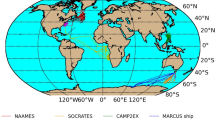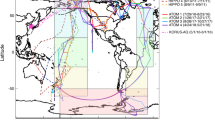Abstract
Emissions of nitrogen oxides (NOx, the sum of NO and NO2) from fossil-fuel burning dominate the NOx burden of the lower troposphere in many regions1. These emissions increase tropospheric ozone and hydroxyl-radical concentrations over their natural ‘background’ levels, thereby increasing the oxidizing power of the atmosphere2. Fossil-fuel emissions of NOx (refs 3, 4) account for about half of the global NOx source to the atmosphere; other significant sources are from biomass burning5, soil emissions6, aircraft exhausts7 and lightning8, all primarily continental. However, ocean-going ships burning fossil fuels may also contribute a significant fraction (>10%) to global NOx production9. Here we use NOx emission data and a high-resolution chemistry–transport model to estimate that ship NOx emissions result in a more than 100-fold increase in surface NOx concentrations in heavily traversed ocean regions. This enhancement has a notable effect on modelled surface ozone and hydroxyl-radical concentrations. In particular, a predicted fivefold increase in the July hydroxyl-radical burden over the northern Atlantic and Pacific oceans would be expected to reduce the atmospheric lifetimes of reactive greenhouse gases—such as methane—as well as to increase aerosol production rates and cloud reflectivities, therefore exerting a cooling influence on the climate.
This is a preview of subscription content, access via your institution
Access options
Subscribe to this journal
Receive 51 print issues and online access
$199.00 per year
only $3.90 per issue
Buy this article
- Purchase on Springer Link
- Instant access to full article PDF
Prices may be subject to local taxes which are calculated during checkout


Similar content being viewed by others
References
Kasibhatla,P. S., Levy,H. & Moxim,W. J. Global NOx, HNO3, PAN, and NOy distributions from fossil fuel combustion emissions: A model study. J. Geophys. Res. 98, 7165–7180 (1993).
Crutzen,P. J. & Zimmermann,P. H. The changing photochemistry of the troposphere. Tellus 43A–B, 136–151 (1991).
Benkovitz,C. M. et al. Global gridded inventories of anthropogenic emissions of sulfur and nitrogen. J. Geophys. Res. 101, 29239–29253 (1996).
Olivier,J. G. et al. Description of EDGAR Version 2.0. A Set of Global Emission Inventories of Greenhouse Gases and Ozone-depleting Substances for all Anthropogenic and Most Natural Sources on a Per Country Basis and on 1° × 1° Grid (Rep. no. 771060 002 RIVM (National Institute of Public Health and the Environment, Bilthoven, 1996).
Crutzen,P. J. & Andreae,M. O. Biomass burning in the tropics: Impact on atmospheric chemistry and biogeochemical cycles. Science 250, 1669–1678 (1990).
Yienger,J. J. & Levy,H. Empirical model of global soil-biogenic NOx emissions. J. Geophys. Res. 100, 11447–11464 (1995).
Baughcum,S. L., Henderson,S. C., Hertel,P. S., Maggiora,D. R. & Oncina,C. A. Stratospheric Emissions Effects Database Development (CR-4592, NASA, Washington DC, 1994).
Lawrence,M. G., Chameides,W. L., Kasibhatla,P. S., Levy,H. & Moxim,W. in Handbook of Atmospheric Electrodynamics (ed. Volland, H.) 189–202 (CRC, Boca Raton, 1995).
Corbett,J. J., Fischbeck,P. S. & Pandis,S. N. Global nitrogen and sulfur inventories for oceangoing ships. J. Geophys. Res. 104, 3457–3470 (1999).
Carlton,J. S. et al. Marine Exhaust Emissions Research Programme (Lloyd's Register Engineering Services, London, 1995).
Dataset of Ships 100 GRT or Greater (Lloyd's Maritime Information Services, Stamford, Connecticut, 1996).
Malony,M. J. World Energy Database (Energy Information Administration (EIA), Washington DC, 1996).
Lawrence,M. G., Crutzen,P. J., Rasch,P. J., Eaton, B. E. & Mahowald,N. M. A model for studies of tropospheric photochemistry: Description, global distributions, and evaluation. J. Geophys. Res. (in the press).
Rasch,P. J., Mahowald,N. M. & Eaton,B E. Representations of transport, convection, and the hydrologic cycle in chemical transport models: Implications for the modeling of short lived and soluble species. J. Geophys. Res. 102, 28127–28138 (1997).
The Times Atlas of the World Comprehensive Edition 9th edn (Times Books, London, 1992).
IMO Sub-Committee on Bulk Materials, 22nd Session, Agenda Item 7 (Ref. code IMO, BCH 22/INF.10, International Maritime Organization, London, 1992).
Houweling,S., Dentener,F. & Lelieveld,J. The impact of nonmethane hydrocarbon compounds on tropospheric photochemistry. J. Geophys. Res. 103, 10673–10696 (1998).
Sander,R. & Crutzen,P. J. Model study indicating halogen activation and ozone destruction in polluted air masses transported to the sea. J. Geophys. Res. 101, 9121–9138 (1996).
Liu,S. C. et al. Ozone production in the rural troposphere and the implications for regional and global ozone distributions. J. Geophys. Res. 92, 4191–4207 (1987).
Gerbig,C. et al. Fast response resonance fluorescence CO measurements aboard the C-130: Instrument characterization and measurements made during North Atlantic Regional Experiment 1993. J. Geophys. Res. 101, 29229–29238 (1996).
Emmons,L. K. et al. Climatologies of NOx and NOy: A comparison of data and models. Atmos. Environ. 31, 1851–1904 (1997).
Prinn,R. G. et al. Atmospheric trends and lifetime of CH3CCL3 and global OH concentrations. Science 269, 187–192 (1995).
Krol,M., van Leeuwen,P. J. & Lelieveld,J. Global OH trend inferred from methylchloroform measurements. J. Geophys. Res. 103, 10697–10711 (1998).
DeMore,W. B. et al. Chemical Kinetics and Photochemical Data for Use in Stratospheric Modeling (NASA JPL (Jet Propulsion Laboratory), Pasadena, California, 1997).
Raes,F. Entrainment of free tropospheric aerosols as a regulating mechanism for cloud condensation nuclei in the remote marine boundary layer. J. Geophys. Res. 100, 2893–2903 (1995).
Capaldo,K., Corbett,J. J., Kasibhatla,P., Fischbeck,P. & Pandis,S. N. Effects of ship emissions on sulphur cycling and radiative climate forcing over the ocean. Nature 400, 743–746 (1999).
Hobbs,P. V. et al. Emissions from ships with respect to their effects on clouds. J. Atmos. Sci. (in the press).
Houghton,J. T. et al. (eds) Climate Change 1994 (Cambridge Univ. Press, 1995).
Kalnay,E. et al. The NCEP/NCAR 40-year reanalysis project. Bull. Am. Met. Soc. 77, 437–471 (1996).
Acknowledgements
We thank P. Rasch and B. Eaton for MATCH support, and J. Olivier for information on the EDGAR ship emissions dataset. This work was supported by the EU SINDICATE project.
Author information
Authors and Affiliations
Corresponding author
Rights and permissions
About this article
Cite this article
Lawrence, M., Crutzen, P. Influence of NOx emissions from ships on tropospheric photochemistry and climate. Nature 402, 167–170 (1999). https://doi.org/10.1038/46013
Received:
Accepted:
Issue Date:
DOI: https://doi.org/10.1038/46013
This article is cited by
-
Negative impact of constant RPM control strategy on ship NOx emission in waves
International Journal of Energy and Environmental Engineering (2023)
-
Simple physical mixing of zeolite prevents sulfur deactivation of vanadia catalysts for NOx removal
Nature Communications (2021)
-
NO adsorption and temperature programmed desorption on K2CO3 modified activated carbons
Journal of Central South University (2018)
-
Current and future emission estimates of exhaust gases and particles from shipping at the largest port in Korea
Environmental Science and Pollution Research (2014)
-
Field applications of a bio-trickling filter for the removal of nitrogen oxides from flue gas
Biotechnology Letters (2009)
Comments
By submitting a comment you agree to abide by our Terms and Community Guidelines. If you find something abusive or that does not comply with our terms or guidelines please flag it as inappropriate.



